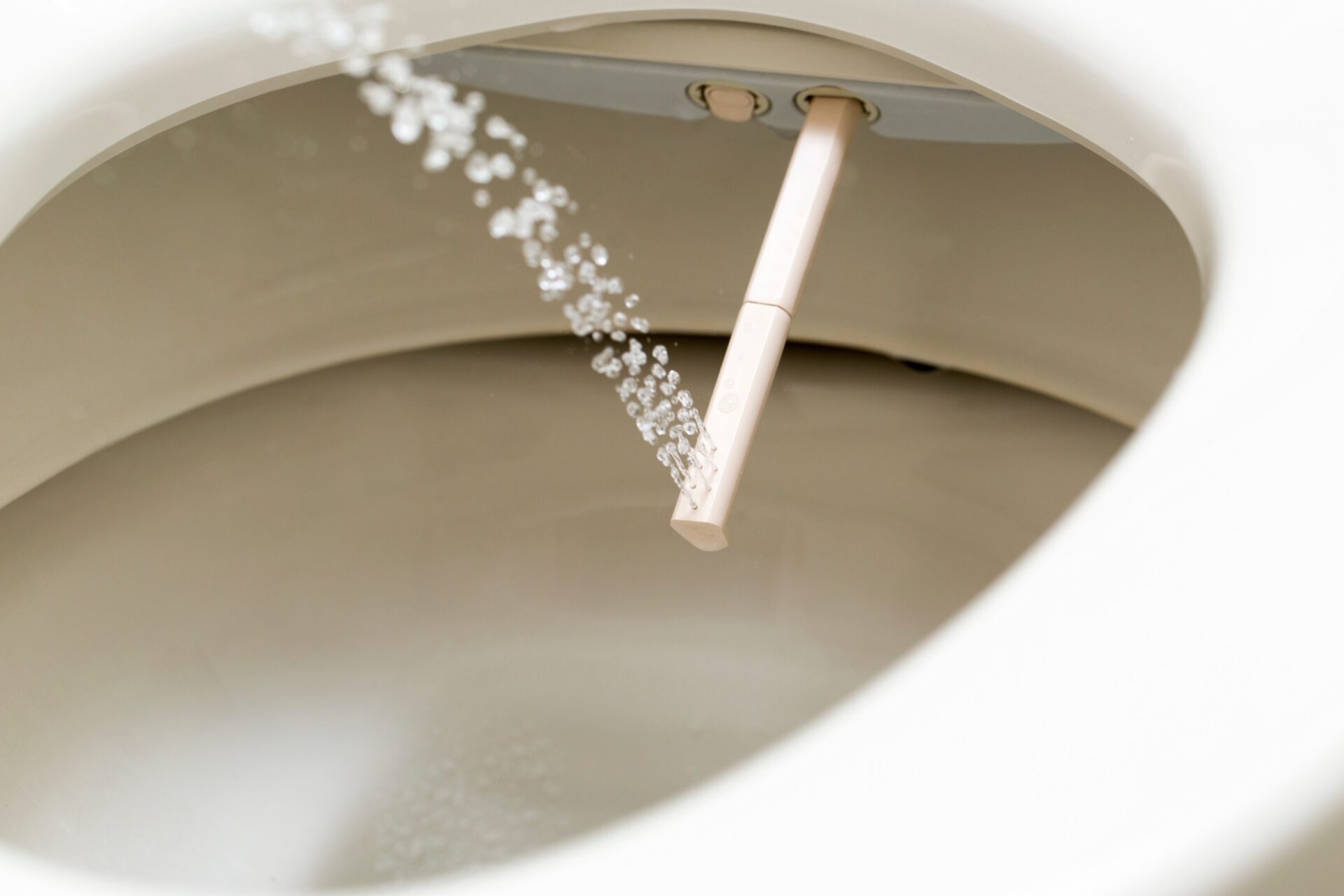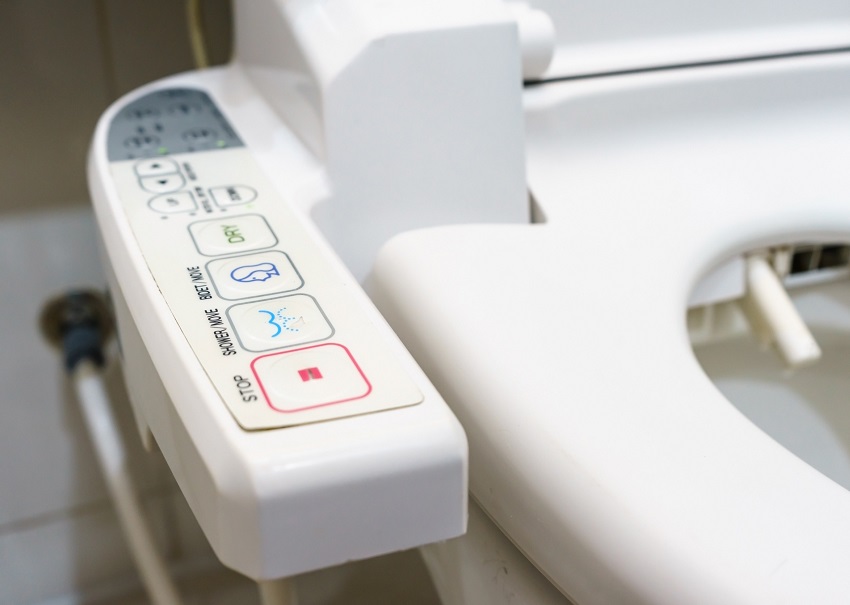“You know how when you go to the bathroom, you have to wipe a zillion times with dry paper? You don’t do that with the bidet. It literally just rinses it off, puts it in the toilet and you pat dry. I wish we’d done it years ago”, says Carrie.
“When you wipe, you’re basically wiping what can be reached,” Nikk says. “When you spray, you get into every nook and cranny, which leaves you way cleaner.”
What is a bidet?
Bidets use water to clean your private areas instead of toilet paper. Bidets have been around for over 300 years — the first known bidet appeared in France in the 1700s.
Traditionally, they were what you might describe as a really low sink next to the toilet. Bidets now come in all sorts of different shapes and forms and can be found in many countries around the world due to their hygiene, health, and environmental benefits. In fact, installing a bidet has been mandatory in Italy since 1975. They are incredibly popular in Asian, South American and European countries.
In Japan, bidets were taken to the next level when Toto, a Japanese company, made some of its bidets electric. 77% of people there now use a bidet daily. They’re so common there that you’d be hard-pressed to find a toilet in Japan without one.

Types of bidets
There are lots of bidets to choose from if you’re thinking about trying one. The bidet has come a long way since it first caught on among the 17th-century French aristocracy. There are two main types of bidets: standalone fixtures and toilet seat attachments.
Stand-alone bidet:
These are porcelain toilet lookalikes that could be confused with low sinks. There’s a tap on the top of the device that sprays water as you squat or sit. A standalone ceramic bidet requires replumbing your bathroom to install it.
Toilet seat bidet:
Bidet seats replace your existing toilet seat, attaching to the bowl. They draw water from the toilet’s supply line and with the press of a button an electric pump streams water to clean your underparts. Some bidet seats have fancy options, such as a fan dry or seat heaters. Depending on the model, there will be a control panel or remote on the side with different functions. They therefore need electricity from a nearby outlet.
Handheld bidet attachment:
Handheld hoses are an economical, effective option. They attach to the plumbing fixtures from the toilet. Mounted between the ring of your existing toilet seat and the bowl, they don’t require electricity. Heated water is an option if you ask your plumber to help install it.
Why install a bidet in your bathroom
“I had used bidets in other counties and liked the ‘freshness’ which is why we now have one in our home”, says Shelley from Mairangi Bay.
People install and use bidets at home for a variety of reasons, including:
1. Improved hygiene:
Water will always clean more thoroughly than paper. Bidets offer a more thorough cleaning than using toilet paper alone, which can leave behind bacteria and any extra residual.
2. Less wiping:
Some people have a tendency to over-wipe, irritating the skin and sometimes even causing tiny cuts or bleeding. Toilet paper can be abrasive, whereas a bidet delivers a more soothing stream of water. Using a bidet does not mean no wiping though. Wiping with toilet paper is still important. You need to fully dry after using the toilet otherwise excess moisture could lead to an infection.
3. Comfort:
Using a bidet can be more comfortable than wiping with toilet paper, especially for people with sensitive skin or conditions like haemorrhoids.
4. Good if you have problems with mobility:
Bidets are particularly helpful for people with mobility issues, such as arthritis, back pain, morbid obesity or Parkinson’s disease. They minimise the need to use your wrist to get to difficult-to-reach spots. They are also helpful for some seniors with poor hand-eye coordination.
5. Helpful if you have issues in that area:
Bidets are gentler on sensitive skin and reduce pressure. For people with Crohn’s disease or ulcerative colitis, bidets can alleviate discomfort and reduce the chance of ulcers occurring.
6. Cost savings:
Installing a bidet can be a cost-effective way to reduce the amount of toilet paper used. Apparently, for each toilet use, an average consumer uses 8.6 sheets of paper. This equates to around 57 sheets every day and 20,805 sheets every year. That is approximately 10.5kgs of toilet paper annually or about 46 rolls.
7. Environmental benefits:
Bidets are more environmentally friendly – good news for your wallet and the environment. A bidet typically uses less than half a litre of water, while it takes around 140 litres of water and 680g of wood to produce a single roll of toilet paper. By investing in a bidet, you’ll be saving some of the 330-odd trees that are cut down to make a single person’s lifetime supply of toilet paper.
8. Convenience:
Bidets are easy to use and require only water, making them convenient and hassle-free.

Installing a bidet seat
Bidet seats deliver the functionality of a bidet. They are fixed onto an existing toilet. Bidet seats do come in different sizes to suit different toilets. Some bidet suppliers have a list of toilets that their seats suit. But generally, bidets will have a round or elongated seat. Check out some of the bidet seats we’ve installed.
New toilet not required
You do need not to replace the whole toilet pan. A bidet seat is a retrofit product. We can replace the toilet seat with a bidet seat hooked onto your existing water connection. The electronic components of the bidet seats would require a power connection. Ideally, the electrical point needs to be on the left-hand side with water on the right especially if it’s a back-to-wall toilet.
The alternative is to buy a bidet-integrated toilet when you’re next renovating your bathroom.
A convenient and hassle-free option
Bidets are easy to use, hygienic, gentle on the skin, and great for the environment.
“The reality is that most people, when they switch to a bidet, they’re mad at themselves that they didn’t use it earlier, and they consider it a game changer. It’s hygiene at its finest”, says Evan Goldstein, an anal surgeon in New York City and founder of Bespoke Surgical.
Call FlowFix Plumbing on 027 265 4949 for a no-obligation quote for bidet seat installations. We stand by all our plumbing work. You can rest assured that you are getting quality work done by experts.

